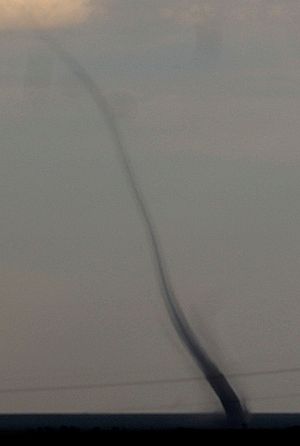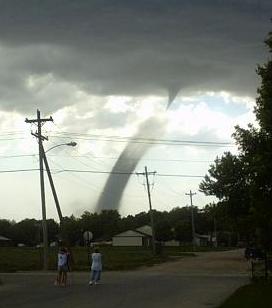Landspout facts for kids

A landspout is a type of tornado. It's a spinning column of air that connects the ground to a cloud. Unlike most tornadoes, landspouts do not form from a mesocyclone. A mesocyclone is a rotating updraft inside a supercell thunderstorm.
The term "landspout" was created in 1985 by scientist Howard B. Bluestein. They are called "landspouts" because they look like a weak waterspout over land. Waterspouts are similar spinning columns of air that form over water. Landspouts are usually weaker than tornadoes that come from supercell thunderstorms.
What is a Landspout?

Landspouts are a kind of tornado that forms when a cumulus congestus cloud or cumulonimbus cloud is growing. This happens when air near the ground starts to spin. An updraft (air moving upwards) then stretches this spinning air. This makes the spin tighter and stronger, forming a vortex.
These tornadoes are generally smaller and not as strong as supercell tornadoes. They do not need a rotating updraft already present in the cloud. Because they are smaller and weaker, Doppler weather radar often cannot detect them.
Landspouts look a lot like waterspouts. They often appear as a clear, smooth, tube-like funnel. The National Weather Service says they are "narrow, rope-like condensation funnels." They form while the thunderstorm cloud is still growing. There is no rotating updraft inside the cloud.
Landspouts are considered true tornadoes. This is because a fast-spinning column of air touches both the ground and a cumuliform cloud. Not all landspouts are easy to see at first. Sometimes, you might first notice dust or debris swirling on the ground. Then, the funnel might fill in with condensation and dust, making it visible.
Sometimes, the shape of the land (like mountains or valleys) can affect where landspouts form. For example, they are common in the Denver Convergence Vorticity Zone in Colorado.
How Long Do Landspouts Last?
A landspout usually lasts for less than 15 minutes. However, some can last much longer. They can also cause significant damage. Landspouts typically go through stages: they form, become strong, and then fade away. They usually disappear when a downdraft (air moving downwards) or heavy precipitation (rain) happens nearby. Sometimes, several landspouts can form in a line or group.
Damage from Landspouts
Landspouts are often weak. But, in rare cases, a landspout can be very strong. Some have been as powerful as an EF3 or EF4 tornado. These are very strong tornadoes that can cause a lot of destruction.
See also
- Dust devil
- Fire whirl
- Funnel cloud
- Tornadogenesis
- Vortex engine
- Whirlwind

